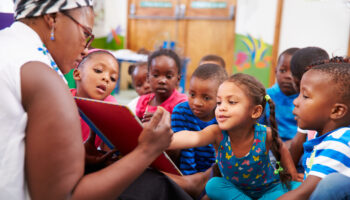Beth Simon with assistance from ChatGPT
August 9th marks a special day that bookworms eagerly anticipate – Book Lovers Day! As early childhood educators, we understand the profound impact that books can have on young children’s development and learning. From sparking imagination and curiosity to fostering language and literacy skills, books hold the power to transform young minds and hearts. Let’s celebrate the wonders of reading and explore ways to cultivate a love of books in the hearts of children in our classrooms.
I would consider myself an avid reader as an adult. That wasn’t always the case. As a child I was read to by family, but not regularly. Books were sometimes used at home and in school as a form of punishment or to get me/us to be quiet and get out of the adult’s hair. Now, I read for escape, to learn about history, and get lost in another world. I share a love of reading with other friends and family members, and we share our opinions or review of books, we discuss the story line and favorite quotes and characters. It’s a form of connection revolving around a favorite hobby. Although my enthusiasm for reading came back to me as an adult, it doesn’t for everyone. With increased screen time for many activities, it’s critical that we as early childhood educators encourage young children to take time away and get lost in the adventures, facts, mystery, fantasy and magic that books hold. Here are some ways to encourage the magic in young readers (and pre-readers):
- Create a Cozy Reading Corner: Designate a cozy corner or reading nook in your classroom where children can immerse themselves in the enchanting world of books. Provide comfortable seating, soft pillows, and shelves filled with a diverse selection of age-appropriate books. Make it a welcoming and inviting space that encourages children to explore and enjoy books at their own pace.
- Storytime Adventures: Organize regular story time sessions where children gather together to listen to captivating stories read aloud by the teacher or guest readers. Use expressive voices, gestures, and props to bring stories to life and engage children’s imagination. Encourage active participation by asking open-ended questions and inviting children to share their thoughts and reactions to the story. Make sure that books are large enough for all children to see or break a large group of children into smaller groups for more participation.
- Incorporate Literacy into Daily Activities: Integrate literacy-rich activities into daily routines and classroom experiences. Label classroom objects with words and pictures, create themed literacy centers with hands-on activities related to books, and encourage children to write and illustrate their own stories or journals. Make literacy a natural and integral part of children’s daily lives.
- Expand Horizons with Diverse Books: Embrace diversity and inclusion by incorporating a wide range of books that reflect children’s diverse backgrounds, cultures, and experiences. Seek out books with characters of different races, ethnicities, abilities, genders, family structures, and socio-economic backgrounds. Encourage children to explore different perspectives and celebrate the beauty of diversity through literature.
- Find Books that Interest Children: Use theme-related stories, rhymes, poems, comic books, and books to further learning. Help preschoolers and school-age children to find books that interest them. Observe children’s interests and add reading material that’s age appropriate and expands their curiosity.
- Foster a Love of Learning: Cultivate a positive attitude towards books and reading. Reading daily to babies and toddlers increases their language and communication skills. Preschoolers may listen to audiobooks or begin following along to simple word/picture books. Continue to build that positive attitude by celebrating children’s accomplishments and milestones. Create a reading log or book chart for older children where children can track the amount of time or number of books they’ve read or listened to. Recognize and reward children’s efforts and achievements with praise, stickers, or small incentives to reinforce their love of learning and reading.
Book Lovers Day is a wonderful opportunity to celebrate the joy and wonder of books. By nurturing a love of books from an early age, we can ignite children’s curiosity, expand their horizons, and lay the foundation for a lifelong love of reading and learning. Let’s embrace the magic of books and inspire the next generation of book lovers in our classrooms. Happy Book Lovers Day!
Reading With Your Child
Read it Again! Benefits of Reading to Young Children
How to Teach Your Child to Love Reading




